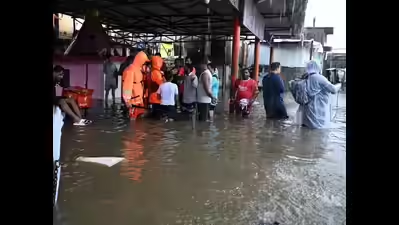Mumbai Drowns Again: Overflowing Mithi River Exposes City’s Civic Complacency
Mumbai’s lifeline, the suburban railway network, came to a grinding halt on August 19 as relentless rainfall and the overflowing Mithi River crippled transport across India’s financial capital. The chaos highlighted once again how little has changed despite years of promises from civic authorities to make Mumbai “monsoon-ready.”
The nightmare began Tuesday morning as heavy rain lashed the city, coinciding with a high tide of 3.74 metres. The Mithi, which has long been reduced to a nullah, reclaimed its identity as a raging river, spilling over its banks and flooding rail lines and roads.
By 9:30 am, Central Railway (CR) officials reported that the Mithi was crossing the danger mark, forcing the closure of floodgates at Kurla. With nowhere for the water to go, it surged back onto tracks, bringing Mumbai’s bustling rail network to a standstill.
From 11:30 am to 7:30 pm, trains on the Main and Harbour lines—across Kurla, Sion, Matunga, Chunabhatti and Govandi—remained non-operational. Western Railway (WR) limped along with severe delays, especially on the Mahim-Dadar stretch.
A staggering 45% of CR’s 1,810 daily services were cancelled, along with 100 WR services. Sixteen long-distance trains were rescheduled, 14 cancelled, and several short-terminated at Pune, Nashik and Panvel.
“The water level was 11 inches between Sion and Kurla, and 19 inches between Kurla and Chunabhatti—far beyond the permissible limits of 6 inches for local and 4 inches for long-distance trains,” a CR official explained. Despite deploying pumps, drainage efforts proved futile as floodwaters rose rapidly.
By midday, water levels in the Mithi reached 3.8 metres, well above the railway’s safety threshold of 2.7 metres.
The Dharavi nullah, funnelling the river through a narrow culvert beneath railway lines and roads, became a choke point. By 11:20 am, train services between Kurla and Chunabhatti were suspended, and shortly after, services on the Kurla-Sion stretch were also stopped, severing connectivity between South Mumbai and the eastern suburbs.
Over 800 train services were cancelled, paralysing the commute of millions. The Vasai-Virar belt also faced significant waterlogging, forcing further slowdowns. Commuters were stranded for hours, while stations and tracks turned into temporary reservoirs.
CR authorities scrambled to restore operations, eventually resuming services on certain stretches by evening, including a special Kurla-Kalyan service. Shuttle trains were deployed in limited corridors, while helpdesks were set up at major stations such as CSMT, Thane, Panvel, Dadar and Mumbai Central.
Rail commuters like Siddesh Desai of the Mumbai Rail Pravas Sangh called the episode “nothing less than a natural calamity,” praising railway staff but questioning why the city still crumbles under predictable monsoon fury.
Roads No Better
The road network fared no better. BEST diverted 114 bus routes at 38 flood-prone points, while running over 2,400 buses, including 60 special services, to ferry stranded passengers. LBS Road on the Sion-Kurla stretch remained one of the worst-hit areas.
Auto rickshaws and taxis largely stayed off the roads, with 40% of vehicles not operational. Ride-hailing apps saw surges and delays of up to 20 minutes, further complicating travel.
The Bigger Question: Why Was Mumbai Unprepared?
The Mithi River has been a recurring flashpoint in every major monsoon disaster in Mumbai. Years after the catastrophic 2005 floods, and crores of rupees spent on desilting and drainage upgrades, this week’s chaos has sparked a familiar refrain: Why is Mumbai still paralysed every time it rains?
Urban planners have long warned that high tides coinciding with intense rainfall would overwhelm the city’s outdated stormwater drains and narrow culverts.
Civic authorities insist that pumping stations and river widening projects are in place, yet the Mithi’s swelling waters proved otherwise. Residents are left wondering if infrastructure investments have been more about paperwork than preparedness.
As Mumbai reels from another monsoon meltdown, the unanswered questions echo louder than the storm itself: How many more wake-up calls does the city need before action matches intent?
#MumbaiFloods #MithiRiver #MonsoonChaos #RailwayDisruption #UrbanPlanningFail #MumbaiMonsoon #CityInCrisis #CivicNegligence

